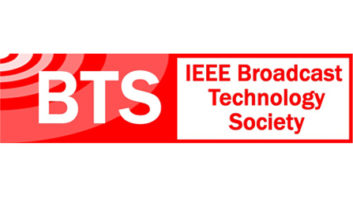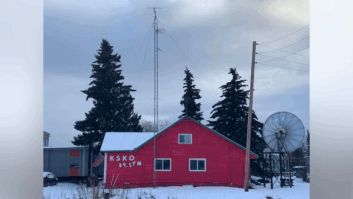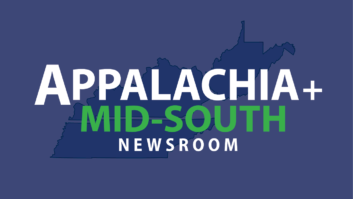
The warm California sunshine allowed several IEEE Broadcast Symposium events to be held outdoors. BTS President Bill Meintel, center, presents certificates of appreciation to event co-chairs David Layer, left, senior director of advanced engineering at NAB, and Paul Shulins, director of technical operations for Greater Media Boston, in a rooftop luncheon awards ceremony.
Credit: Photos by James O’Neal SAN DIEGO — The IEEE’s annual Broadcast Technology Society Fall Symposium, Oct. 9–11, drew approximately 110 participants from the United States and nine other nations, according to organizers.
Although the majority of the event’s focus was on television-related developments and technologies, radio broadcasting was not ignored. Audio transport for radio studios, audio codecs and digital connectivity for FM stereo were discussed. So, too, were new FCC rules to protect AM broadcasters from pattern interference caused by nearby structures and the use of voltage sampling units to facilitate AM directional proof-of-performance measurements.
BAD AM NEIGHBORS
As the number of cellphone antenna sites continues to grow, so does the threat of pattern changes to nearby AM broadcast operations from signal re-radiation. However, there is hope for beleaguered facility owners. Ben Dawson, managing partner of Hatfield & Dawson Consulting Engineers, discussed the situation in his presentation “The Effects of Nearby Structures on MF Antennas and the FCC’s Newly Enacted Rules for Protecting AM Stations From Those Effects.”
“The presence of possibly re-radiating structures near AM antenna systems has been a problem for a long time and the FCC’s behavior with respect to those problems has varied over time,” said Dawson. “But we have the benefit now of a newly enacted set of rules that we think that will allow the proponents of a new structure construction involving FCC licensing to at least to have a clear understanding of what’s necessary to mitigate the possible deleterious effects on nearby AM stations.”
Radio World reported on the changes in October.
Dawson presented a brief history of AM directional antennas — their implementation dates to the 1930s — and described some of the difficulties in making proper pattern measurements in real-world situations. He noted that this led to a petition to the FCC in 1989 to allow “method of moment” techniques in directional proofs, as well as for evaluating re-radiation problems caused by nearby metallic structures. The commission eventually acted on the proposal.
“It took them until 2008 to adopt the rules we suggested after a long series of industry discussions,” said Dawson.

Once recently-passed FCC rules go into effect, AM broadcasters will be afforded protection from encroaching cell site towers and masts, according to Ben Dawson of Hatfield & Dawson, shown. “But one thing they didn’t adopt was the technique for determining the effect of potential re-radiation from other licensed service providers.”
That determination was acted on a few weeks ago; it was to take effect upon publication in the Federal Register, which was still pending. Once effective, AM broadcasters will be afforded protection from encroaching cell site towers and masts. Owners of such structures will be required to perform remedial actions such as adding detuning networks, within certain limits.
“For an omni[directional] antenna, the potential re-radiator has to be 60 degrees or more in height and within one wavelength of the AM antenna; for a directional it has to be within the lesser of 10 wavelengths or three kilometers from the reference coordinates of the antenna system and at least 36 degrees tall,” Dawson said.
“If a new structure or the modified structure would cause pattern distortion more than ±2 dB for a non-directional antenna, then it should be detuned. If it’s a directional antenna, then the pattern distortion has to not exceed the value of the standard or augmented pattern for that station. If these thresholds are exceeded then the tower proponents are responsible for whatever detuning is necessary.”
Dawson told Radio World that while the new rule will protect broadcasters from cell site or other licensed user re-radiation problems, it doesn’t address other potential re-radiators such as permanently installed or long-term “temporary” construction cranes, bridges, power lines and, most recently, wind turbines. The commission has no jurisdiction over such devices and structures.
NEW VENUE
For more than 60 years, the BTS Symposium was in Washington. Last year, organizers said they would move the event to the West Coast in an effort to draw more and different attendees. The aim was also to make the event more accessible to Western states’ BTS members.
San Diego was chosen for the conference after a number of options were explored, according to Paul Shulins, the co-organizer and director of technical operations for Greater Media’s Boston cluster.
“In addition to being an easy-to-get-to and a desirable destination, San Diego is in close proximity to Los Angeles and several other large western U.S. markets where a sizable number of IEEE BTS members are located,” said Shulins. “This venue provided many of these members an easy opportunity to see what a worthwhile event we hold every year.”
Overall, the response to the new location was good, according to Shulins.
“This was a big experiment and we’re very pleased with the turnout,” said Shulins. “We’re seeing a lot of familiar faces, but we’re also seeing some new faces, which was our real goal — to expose the symposium to some new people. The venue is wonderful and the people are wonderful here, and we’re hoping to expand it again next year when we move it to San Antonio, Texas.”
Find details about the 2013 symposium and future conference events on the BTS website, bts.ieee.org.
James O’Neal is technology editor of TV Technology and a contributor to Radio World. He also is a member of the symposium committee, representing his television equipment consultancy.







